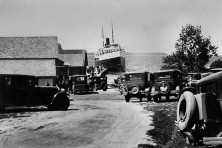A Different Look at Ephraim
- Share
- Tweet
- Pin
- Share

Scenes of Ephraim recorded on 4 x 5-inch glass plates could be the stars of the Ephraim Historical Foundation’s 2024 exhibition.
“The glass plates were made in the early 1910s and were still in their original paper envelopes,” said Jeff O’Keeffe, Curator and Collections manager, who has since transferred them to archival housing while preserving the original envelopes with their written descriptions of the scenes, and often information about the type of film and the lenses used. The photographer was Frank Watson, an early summer resident who was an insurance salesman by profession but also an avid photographer.
O’Keeffe is well prepared for this with a Bachelor of Arts in Photography and a minor in Visual Arts Management from Columbia College in Chicago. And although he has thousands of hours of darkroom work, he doesn’t plan to develop prints from the glass plates in a dark room – he will scan them to make prints.
The exhibit will feature photography including work by Frieda Brenner who ran a photography studio in Milwaukee in the thirties and forties and then moved her studio to Ephraim with her her partner, Mayble Holland, a painter who had a masters in art education from Columbia University in New York and studied in Europe in 1936.
Brenner was an active photographer into the 1960s and photographed prominent area individuals including, for several years, making portraits of the village’s Fyr Ball chieftains. Holland taught art during the summers for 12 years from 1954 and painted local scenes including the Eagle Bluff Lighthouse in Peninsula State Park, the Ephraim Moravian Church and the Pioneer Schoolhouse. Although several of her paintings are in the foundation’s wonderful book Picturing the Past: The Ephraim Historical Foundation’s Art Collection, the exhibition won’t show paintings this time – the exhibition is focused on photography.
“We have a large collection of photographs,” O’Keefe said. “I am trying to give an overview of how people made pictures here over time, and show off our collection.”
The photographs provide some fascinating historical perspective, showing an almost completely different landscape. A Watson photograph looks down an unpaved Water Street and shows Wilson’s and two steeples, but the village hall wasn’t built yet.

He is selecting historical photographs that are “visually interesting, tell stories, and that we can tell stories about,” O’Keeffe said.
The Foundation’s barn, where the exhibition will be shown in 2024 from mid-June to mid-October, is at the northern end up the hill from the Hardy Gallery and the Anderson Store. The store and the Pioneer Schoolhouse attract the most visitors, O‘Keefe said, but last summer’s exhibition, Smörgåsbord: Foodways That Defined Ephraim, drew nearly 2,000 visitors.
O’Keefe continued an audit of the Foundation’s archival collection and assessed over 1,000 individual historic items last summer alone. The collection continues to grow with donations from local families, such as sailing logs with records of regatta results and photos of the boats under sail.



